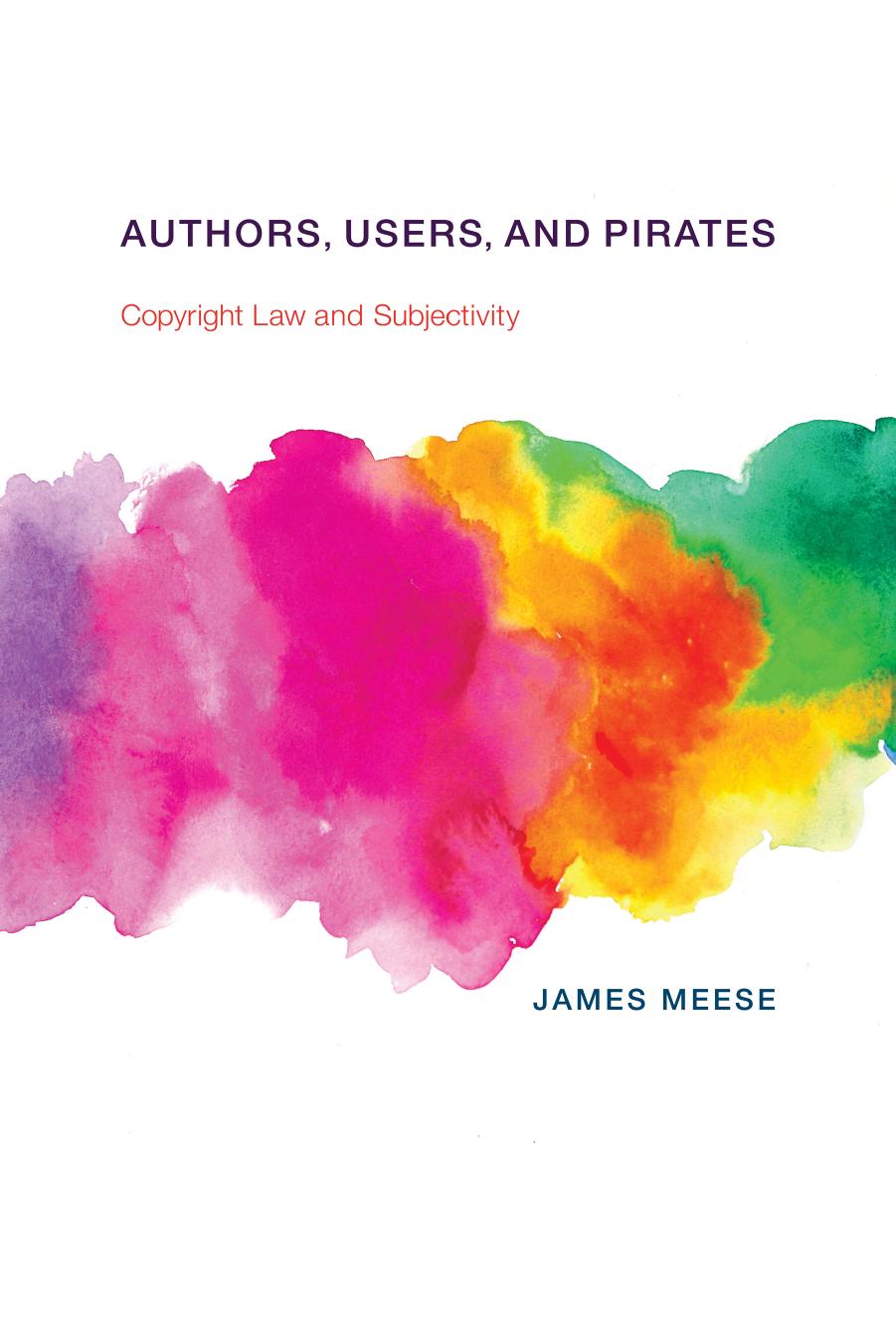Authors, Users, and Pirates: Copyright Law and Subjectivity by James Meese

Author:James Meese
Language: eng
Format: epub, pdf
Tags: Language Arts & Disciplines, Philosophy & Social Aspects, Law, pirate, Authorship, copyright law; digital media; intellectual property law; cultural studies; subjectivity; relationality, Social Aspects, Political Science, authorship; piracy; use; legal theory; creativity; author, Public Policy, Copyright, Technology & Engineering, Intellectual Property, science, Science & Technology Policy, user; social media; relational; peer-to-peer networks; legislation; artistic practice; IP policy; sampling; music; media regulation; media distribution; United States copyright law; United States; Canada; Canadian copyright law; Australia; Australian copyright law; United Kingdom; U.K. copyright law; common law; statutory law; participatory culture; innovation; remix; online piracy; fair use; fair dealing; user generated content; abridgment; contemporary art; information law; digital rights; user rights
Publisher: MIT Press
Published: 2018-02-16T01:05:02.689000+00:00
What’s in a Name? Regulating User-Generated Content
At first glance, the Canadian UGC exception appears to be a clever piece of legal reform. Copyright law needs to respond to the challenges posed by the Internet and digital media more generally, so it is hard not to instinctively welcome a reform that directly addresses the phenomenon of amateur or user creativity by taking a broad and generally flexible approach. If we look at this amendment more closely, however, it becomes clear that despite its attempt at embracing a relational approach to subjectivity, it entrenches a hierarchy around what kinds of creativity can be commercially exploited.
The provision places a number of restrictions around the use of copyrighted works for UGC. Most notably, the exception allows people to engage in this sort of use for non-commercial purposes only. As Teresa Scassa notes, the exception “perpetuates the myth that the regular ‘creator’ does not borrow from or use the works of others [and] constructs UGC as a more parasitic activity than perhaps it deserves to be.”34 I have also noted elsewhere that “the exception immediately discounts the transformative elements of actions like remix, mash-up or the deployment of professional content in amateur settings.”35 Although this exception cannot stop someone from building on an existing copyrighted work to create a new original work, it discourages a user–author from exploiting this new work commercially, inadvertently setting boundaries around authorial creation. Under this exception, “real” authors can commercially exploit creations whereas “users” can only “generate content” in a non-commercial space.
An additional exception reinforces this creative hierarchy. Paragraph 29.21(1)(d) allows users to create works drawing on existing copyrighted material only as long as the new work does not have a “substantial adverse effect financial, or otherwise, on the exploitation or potential exploitation of the existing work.”36 This sort of creation is therefore still “subject to the whims of the rights holder through this ‘open-ended’ exception.”37 Scassa explains that rights holders could use this exception to argue that a particular use “diminishes the cultural impact or significance of the [original] work by trivializing it, or … tarnishes the reputation of the [original] work as, for example, where fan fiction strays into the pornographic.”38 Once again, this exception places the creativity of “users” under significantly more scrutiny than that of “authors.” Whereas the authorial creativity defended by copyright law requires only the production of a work that is original and fixed in a material form, under these UGC provisions any creativity that rests on the use of copyrighted material has to negotiate a number of exceptions and runs the risk of drawing the ire of the original copyright holder.
The UGC provision links the user with the author by recognizing that users can create and by developing a pathway that legalizes this sort of “secondary” creation. Yet this sort of creativity is not seen as equivalent to “authorial” creativity. The way the exceptions are structured implies that authors are engaged in an autonomous creative process that develops new original works, whereas users
Download
Authors, Users, and Pirates: Copyright Law and Subjectivity by James Meese.pdf
This site does not store any files on its server. We only index and link to content provided by other sites. Please contact the content providers to delete copyright contents if any and email us, we'll remove relevant links or contents immediately.
| Arms Control | Diplomacy |
| Security | Trades & Tariffs |
| Treaties | African |
| Asian | Australian & Oceanian |
| Canadian | Caribbean & Latin American |
| European | Middle Eastern |
| Russian & Former Soviet Union |
The Secret History by Donna Tartt(18846)
The Social Justice Warrior Handbook by Lisa De Pasquale(12141)
Thirteen Reasons Why by Jay Asher(8796)
This Is How You Lose Her by Junot Diaz(6794)
Weapons of Math Destruction by Cathy O'Neil(6146)
Zero to One by Peter Thiel(5686)
Beartown by Fredrik Backman(5599)
The Myth of the Strong Leader by Archie Brown(5425)
The Fire Next Time by James Baldwin(5249)
How Democracies Die by Steven Levitsky & Daniel Ziblatt(5128)
Promise Me, Dad by Joe Biden(5087)
Stone's Rules by Roger Stone(5026)
A Higher Loyalty: Truth, Lies, and Leadership by James Comey(4844)
100 Deadly Skills by Clint Emerson(4840)
Rise and Kill First by Ronen Bergman(4704)
Secrecy World by Jake Bernstein(4646)
The David Icke Guide to the Global Conspiracy (and how to end it) by David Icke(4625)
The Farm by Tom Rob Smith(4437)
The Doomsday Machine by Daniel Ellsberg(4416)
